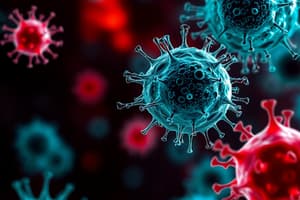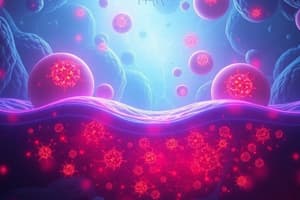Podcast
Questions and Answers
What is a function of C5a?
What is a function of C5a?
- Inhibiting bronchoconstriction
- Chemotactic agent for neutrophils and macrophages (correct)
- Regulating immunoglobulin production
- Histamine release from mast cells
What is a consequence of complement deficiencies?
What is a consequence of complement deficiencies?
- Increased risk of parasitic infections
- Increased risk of viral infections
- Increased risk of bacterial infections (correct)
- Increased risk of fungal infections
What is a specific function of C1q?
What is a specific function of C1q?
- Recognizing phosphatidylserine on apoptotic cells (correct)
- Recognizing phospholipids on apoptotic cells
- Recognizing immunoglobulin G on bacterial surfaces
- Recognizing mannose on bacterial surfaces
What is associated with deficiencies in C1q?
What is associated with deficiencies in C1q?
What is a characteristic of the classical pathway?
What is a characteristic of the classical pathway?
What is a potential consequence of impaired clearance of apoptotic cells?
What is a potential consequence of impaired clearance of apoptotic cells?
Which Toll-like receptor detects peptidoglycans, a major component of the cell wall of gram-positive bacteria?
Which Toll-like receptor detects peptidoglycans, a major component of the cell wall of gram-positive bacteria?
In which compartment are Toll-like receptors found?
In which compartment are Toll-like receptors found?
What type of pathogens do RIG-like receptors detect?
What type of pathogens do RIG-like receptors detect?
Where are C-type Lectin receptors typically found?
Where are C-type Lectin receptors typically found?
What is the downstream effect of NLR activation?
What is the downstream effect of NLR activation?
What type of pathogens do C-type Lectin receptors detect?
What type of pathogens do C-type Lectin receptors detect?
Where are NOD-like receptors typically found?
Where are NOD-like receptors typically found?
What type of pathogens do Toll-like receptors tend to recognize?
What type of pathogens do Toll-like receptors tend to recognize?
What is the primary function of the complement system?
What is the primary function of the complement system?
What is the common outcome of all pathways of the complement cascade?
What is the common outcome of all pathways of the complement cascade?
Which pathway of the complement system is triggered by the binding of antibodies to a pathogen?
Which pathway of the complement system is triggered by the binding of antibodies to a pathogen?
What is the role of C3b in the complement cascade?
What is the role of C3b in the complement cascade?
What is the function of the C5 convertase?
What is the function of the C5 convertase?
What is the role of the membrane attack complex (MAC) in the complement cascade?
What is the role of the membrane attack complex (MAC) in the complement cascade?
What is the function of C1q in the classical pathway?
What is the function of C1q in the classical pathway?
What is the role of properdin in the alternative pathway?
What is the role of properdin in the alternative pathway?
What is the consequence of unregulated complement activation?
What is the consequence of unregulated complement activation?
What is the role of decay-accelerating factor, factor H, and factor I in the complement cascade?
What is the role of decay-accelerating factor, factor H, and factor I in the complement cascade?
What is the primary function of resident macrophages in tissues?
What is the primary function of resident macrophages in tissues?
Which cell type is responsible for detecting PAMPs in blood and lymph vessels?
Which cell type is responsible for detecting PAMPs in blood and lymph vessels?
What is the primary function of IL-1, TNF-alpha, and IL-6?
What is the primary function of IL-1, TNF-alpha, and IL-6?
What is the result of IL-1, TNF-alpha, and IL-6 acting on the hypothalamus?
What is the result of IL-1, TNF-alpha, and IL-6 acting on the hypothalamus?
What is the primary source of IL-6?
What is the primary source of IL-6?
What is the effect of IL-1, TNF-alpha, and IL-6 on vascular permeability?
What is the effect of IL-1, TNF-alpha, and IL-6 on vascular permeability?
What is the role of CRP and mannose-binding lectin in acute inflammation?
What is the role of CRP and mannose-binding lectin in acute inflammation?
What is the benefit of fever in acute inflammation?
What is the benefit of fever in acute inflammation?
What is the mechanism of peripheral vasoconstriction in fever?
What is the mechanism of peripheral vasoconstriction in fever?
What is the characteristic of IL-1, TNF-alpha, and IL-6 in terms of their effects?
What is the characteristic of IL-1, TNF-alpha, and IL-6 in terms of their effects?
What is the primary role of pro-inflammatory cytokines in the context of fever and acute inflammation?
What is the primary role of pro-inflammatory cytokines in the context of fever and acute inflammation?
Which of the following is NOT a major acute phase protein?
Which of the following is NOT a major acute phase protein?
What is the primary function of C-reactive protein (CRP)?
What is the primary function of C-reactive protein (CRP)?
Which of the following is responsible for sequestering iron from microbes?
Which of the following is responsible for sequestering iron from microbes?
What is the primary function of Type 1 interferons (IFN-α and IFN-β)?
What is the primary function of Type 1 interferons (IFN-α and IFN-β)?
What is the primary source of Type 1 interferons (IFN-α and IFN-β)?
What is the primary source of Type 1 interferons (IFN-α and IFN-β)?
How do Type I interferons (IFN-α and IFN-β) provide protection against viral infection?
How do Type I interferons (IFN-α and IFN-β) provide protection against viral infection?
What is the primary role of IFN-γ in the context of the immune response?
What is the primary role of IFN-γ in the context of the immune response?
Which of the following is a characteristic of the antiviral response mediated by Type 1 interferons?
Which of the following is a characteristic of the antiviral response mediated by Type 1 interferons?
What is the primary mechanism by which prostaglandin E2 (PGE2) leads to fever?
What is the primary mechanism by which prostaglandin E2 (PGE2) leads to fever?
Flashcards are hidden until you start studying
Study Notes
The Complement System
- Complement is a blood-borne molecular defense system that "complements" the immunity provided by antibodies
- It aids in phagocytosis, destruction of microorganisms, and inflammation
- Activated through a tightly-controlled enzyme-triggered cascade
- Consists of three pathways: Alternative, Classical, and Lectin pathways
Alternative Pathway
- Complement component 3 (C3) acts as a pattern-recognition receptor, binding to the surface of a pathogen
- C3bBb complex is formed when C3b binds to the bacterial membrane, becoming a stable C3 convertase
- Properdin helps stabilize the entire complex to form the stable C3 and C5 convertases
Lectin and Classical Pathways
- Mannose-binding lectin (MBL) is a circulating pattern-recognition receptor that recognizes mannose residues on bacterial membranes
- C1q binds to the Fc portion of an antibody that has bound to an antigen, triggering the classical pathway
- Both pathways lead to the formation of C3b and C5 convertases
Complement - General Principles
- All pathways lead to the production of a stable C3 convertase
- C3 convertase cleaves C3 into C3b and C3a
- C3b is an important opsonin and causes progression through the rest of the complement cascade
- C5 convertase cleaves C5 into C5a and C5b, leading to the formation of the membrane attack complex (MAC)
Complement - Cell Lysis
- MAC generates a pore in lipid bilayer membranes, causing lysis
- The sequence of events involves the assembly of C5b, C6, C7, C8, and C9, leading to the formation of the pore
- Complement can be damaging to cells if not tightly regulated, and there are proteins that down-regulate or degrade complement components
FAQs about Complement
- C3a and C5a cause vasodilation, increased vascular permeability, smooth muscle contraction, and histamine release from mast cells
- C5a is a chemotactic agent for various cells, including neutrophils and macrophages
- Complement deficiencies can lead to immunodeficiency, and C1q deficiencies are associated with systemic lupus erythematosus
Pattern Recognition Receptors (PRRs)
- Toll-like receptors (TLRs) recognize PAMPs in the extracellular fluid or endosomes
- C-type lectin receptors detect carbohydrate components of microbes
- NOD-like receptors (NLRs) detect bacterial or parasite cell wall components in the cytosol
- RIG-like receptors (RLRs) detect viral RNA in the cytosol
The Sentinels
- Macrophages and dendritic cells are key sentinels for pathogen invasion or tissue damage
- Endothelial cells and epithelial cells also express PRRs and play a role in detecting PAMPs
Inflammatory Mediators
- IL-1, TNF-alpha, and IL-6 are major pro-inflammatory cytokines
- These cytokines have redundant and pleiotropic effects, including inducing fever, increasing vascular permeability, and promoting the production of acute-phase proteins
- IL-6 is a key cytokine that induces the production of acute-phase proteins
Fever and Acute Inflammation
- Fever is a response to the presence of PAMPs and DAMPs, and is caused by the changing of the hypothalamic set-point
- Mechanisms of fever include peripheral vasoconstriction, shivering, and increased metabolic rate
- Fever has benefits, including enhancing the adaptive immune response
Acute Phase Proteins
- Elevated levels of inflammatory cytokines, particularly IL-6, cause the liver to increase the secretion of acute-phase proteins
- Major acute-phase proteins include C-reactive protein (CRP), ferritin, hepcidin, and serum amyloid A (SAA)
- These proteins play a role in sequestering iron, opsonizing pathogens, and modulating the inflammasome and TLRs
NK Cells and IFNs
- Type 1 interferons (IFN-alpha and IFN-beta) are produced by macrophages, dendritic cells, and infected cells, and play a role in protecting against viral infection
- Type 2 interferons (IFN-gamma) are produced by Th cells and NK cells, and play a role in activating macrophages and promoting a cell-mediated response
- NK cells are activated by the presence of infected cells or damaged cells, and differentiate between these cells and normal cells through the recognition of specific ligands
- NK cells kill target cells through the release of perforin and granzymes, leading to apoptosis.
Studying That Suits You
Use AI to generate personalized quizzes and flashcards to suit your learning preferences.




